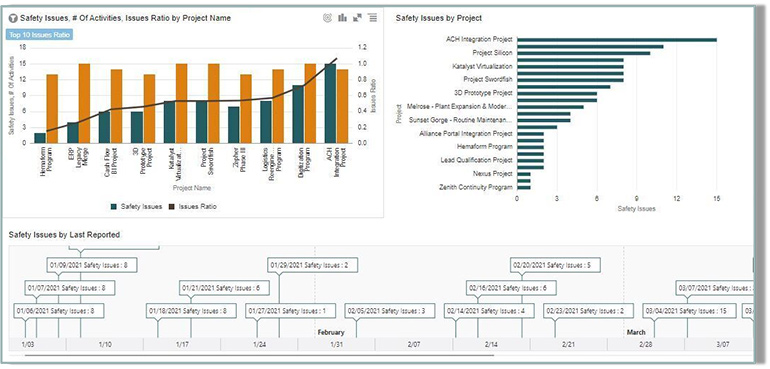In the early days of desktop computers, “networking” meant Ethernet cables running, of lucky, in conduit—often through false ceilings—all throughout the office. The hub-and-spoke, client-server relationship between nodes on the network allowed minimum transfer of data between workstations. There was still need, in many offices, for “sneaker net” (carrying floppy disks between computers).
Times change. While engineering and construction organizations still struggle to unlock data across applications to effectively diagnose problems, predict risks, and inform future actions, companies are working to mitigate these problems. To address this challenge, Oracle introduced Oracle Construction Intelligence Cloud Analytics. The new solution combines data from Oracle Smart Construction Platform applications to give owners and contractors a comprehensive understanding of performance throughout their operations.
With this insight, organizations can quickly spot and correct issues and target ways to drive continuous improvement across project planning, construction, and asset operation. The new Oracle Construction Intelligence Cloud Analytics offering combined with the Smart Construction Platform’s predictive intelligence engine and common data environment, gives users a deeper, holistic understanding of their performance. Now they can build unique data strategies that drive competitive differentiation. Oracle believes this is how the construction industry will get to six sigma precision like its industrial and manufacturing counterparts.

The Smart Construction Platform unites capabilities from Oracle engineering and construction applications and third-party solutions with a common data environment and user experience. With the platform, owners and contractors can more easily work together to improve decision-making at every level of their organizations. The new analytics solution and other platform enhancements were unveiled today at the Oracle Industry Lab in Deerfield, Ill.
The Smart Construction Platform brings together the core applications, processes, and data that owners and contractors need to work together across project and asset lifecycles. These include portfolio planning, bid/tender processes, contracts, schedules, project documents and BIM (building information model) collaboration, field tasks, costs, and payments.
With the new unified experience, common data environment, and cross-application interoperability, users can easily move between applications and data sets while working within a single project. By synchronizing activities, resources, and data as each project and asset progresses, the platform helps ensure teams across disciplines are always working toward the same goal, with the same information.
For instance, the platform’s scheduling and project management capabilities synchronize planning and worksite teams around a master plan, giving both visibility into a unified schedule and the task data needed to do the right work in the right place at the right time. So, if an HVAC installation should change because of a supply-chain issue, the project manager will automatically receive the updated schedule information and can coordinate any needed adjustments across all impacted teams.
Likewise, the platform gives capital planners accurate, timely data on project forecasts so they can align with managers on budget requirements and adjust as strategic priorities change. For example, inflation doubles the costs of a required set of materials on a project. The project manager can push those new actuals and forecast up to the planner who can perform just-in-time changes to the portfolio, possibly pulling funds from a less important project, or putting a project on hold.
And as the platform continually learns and gets smarter using machine learning technologies, it will take these past actions into consideration to flag potential risks and guide more informed decision making in the future. These are just a few of the many connected experiences the platform can deliver by:
- Providing up-to-date schedule data to project managers so they can keep teams aligned to planned delivery dates and other schedule requirements
- Uniting planning (CPM schedule) with worksite teams (task schedule) to minimize wasted time and resources
- Letting capital planning and project execution teams exchange budget and actual cost data, enabling both teams to confidently adjust as work progresses
- Automatically storing completed bid/tender packages as well as approved invoices and other payment materials in organizations’ document registers
- Giving all stakeholders visibility to collectively track progress, identify and mitigate risks, and efficiently manage change across the entire supply chain
Integrated and interlocked applications across multiple sources will speed up and make many construction tasks easier and more accurate. A long way from running floppy disks across the building.
Want to tweet about this article? Use hashtags #construction #sustainability #infrastructure #IoT #AI #5G #cloud #edge #futureofwork


